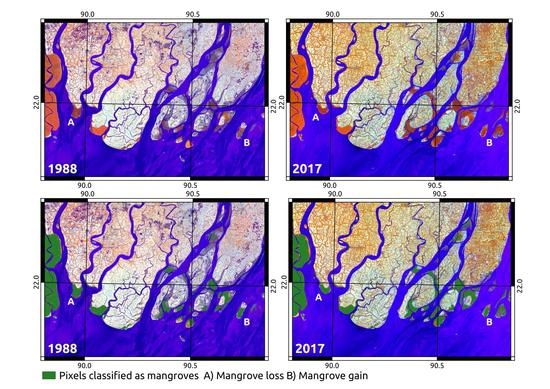Using Continuous Change Detection and Classification of Landsat Data to Investigate Long-Term Mangrove Dynamics in the Sundarbans Region
Abstract
1. Introduction
2. Materials and Methods
2.1. Study Area
2.2. Data and Pre-Processing
2.3. Classification of Mangroves Using CCDC
2.3.1. The CCDC Algorithm
2.3.2. Generation of Yearly Classification Maps
Model Classification
Yearly Maps
Validation
2.4. Long Term Vegetation Trends in the Sundarbans
2.5. Investigation of Dynamics around Cyclone Sidr
3. Results
3.1. Classification of Mangroves Using CCDC
3.2. Long Term Vegetation Trends in the Sundarbans
3.3. Investigation of Dynamics around Cyclone Sidr
4. Discussion
4.1. Classification of Mangroves Using CCDC
4.2. Long Term Vegetation Trends in the Sundarbans
4.3. Investigation of Dynamics around Cyclone Sidr
4.3.1. Comparison to Previous Damage Estimates
4.3.2. Impact of Sidr on Mangrove Extent
4.3.3. Estimation of Recovery from Sidr
5. Conclusions
Author Contributions
Funding
Acknowledgments
Conflicts of Interest
Abbreviations
| ARCSI | Atmospheric and Radiometric Correction of Satellite Imagery |
| ASTER | Advanced Spaceborne Thermal Emission and Reflection Radiometer |
| CCDC | Continuous Change Detection and Classification |
| Fmask | Function of mask |
| GDAL | Geospatial Data Abstraction Library |
| NetCDF | Network Common Data Form |
| NIR | Near-infrared |
| ODC | Open Data Cube |
| SAR | Synthetic Aperture Radar |
| SCW | Super Computing Wales |
| SLC | Scan Line Corrector |
| SWIR | Short Wave Infrared |
| UNESCO | United Nations Educational, Scientific and Cultural Organization |
| USGS | United States Geological Survey |
Appendix A
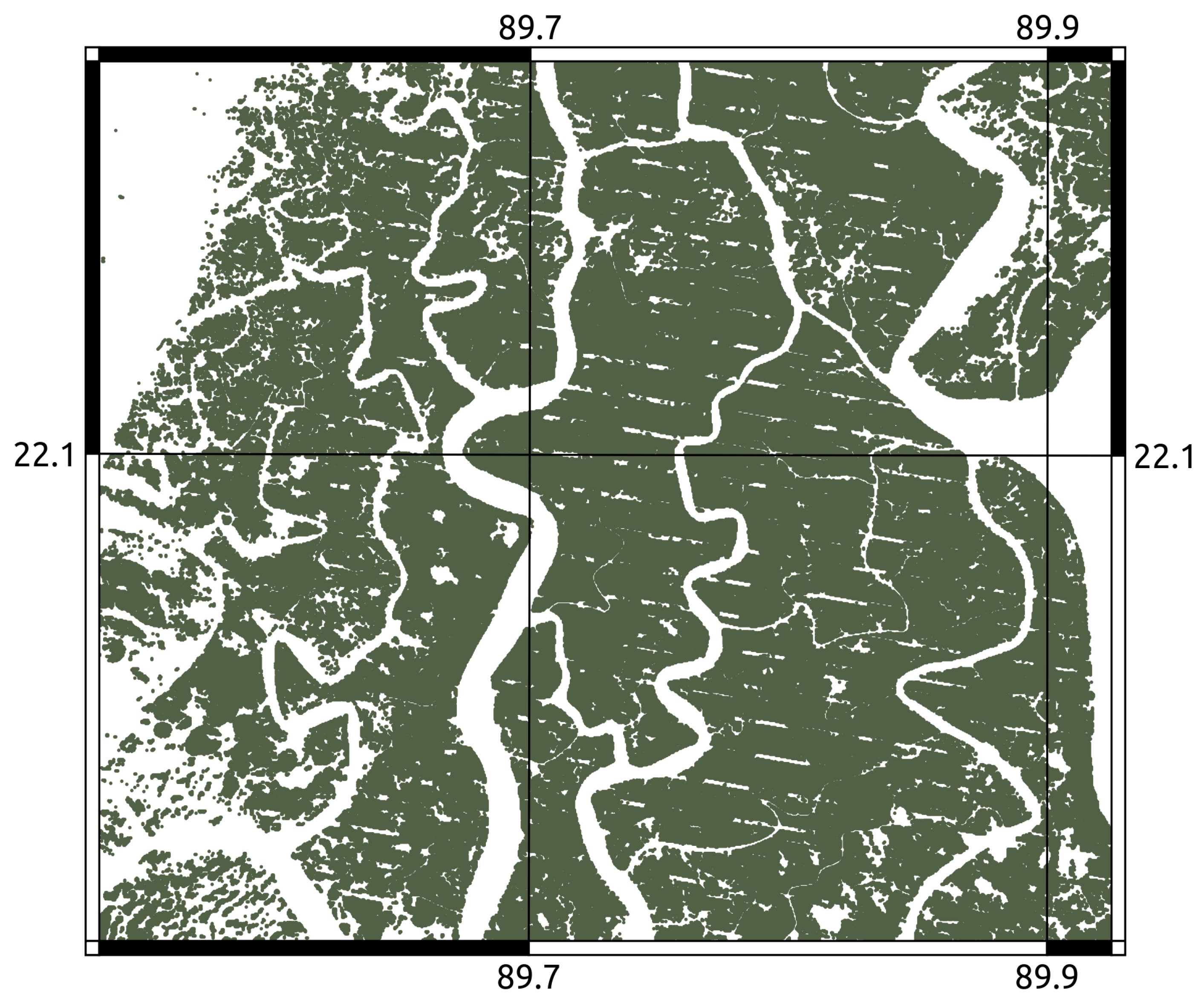
| Year | Change | Net Loss | Net Gain | Total |
|---|---|---|---|---|
| 1988 | - | - | - | 6368.3 |
| 1989 | 39.9 | 86.7 | 126.6 | 6408.2 |
| 1990 | 171.8 | 19.8 | 191.6 | 6580.0 |
| 1991 | 32.6 | 11.9 | 44.5 | 6612.6 |
| 1992 | 15.2 | 5.6 | 20.8 | 6627.8 |
| 1993 | 7.7 | 3.7 | 11.4 | 6635.5 |
| 1994 | 2.9 | 4.5 | 7.4 | 6638.4 |
| 1995 | 10.7 | 4.7 | 15.4 | 6649.1 |
| 1996 | 2.0 | 5.7 | 7.7 | 6651.1 |
| 1997 | 5.0 | 7.0 | 12.0 | 6656.1 |
| 1998 | 4.4 | 6.7 | 11.1 | 6660.5 |
| 1999 | 2.9 | 7.0 | 9.9 | 6663.4 |
| 2000 | 2.5 | 6.5 | 9.0 | 6665.9 |
| 2001 | 0.4 | 10.4 | 10.8 | 6666.3 |
| 2002 | −0.7 | 12.3 | 11.6 | 6665.6 |
| 2003 | 1.5 | 12.9 | 14.4 | 6667.1 |
| 2004 | 5.5 | 11.9 | 17.4 | 6672.6 |
| 2005 | −3.5 | 12.4 | 8.9 | 6669.1 |
| 2006 | −3.0 | 10.6 | 7.6 | 6666.1 |
| 2007 | −90.1 | 105.0 | 14.9 | 6576.0 |
| 2008 | 82.5 | 21.7 | 104.2 | 6658.5 |
| 2009 | −2.5 | 17.4 | 14.9 | 6656.0 |
| 2010 | 9.2 | 9.6 | 18.8 | 6665.2 |
| 2011 | −2.0 | 6.4 | 4.4 | 6663.2 |
| 2012 | −3.2 | 7.0 | 3.8 | 6660.0 |
| 2013 | −3.8 | 9.6 | 5.8 | 6656.2 |
| 2014 | −7.1 | 14.1 | 7.0 | 6649.1 |
| 2015 | −3.4 | 10.0 | 6.6 | 6645.7 |
| 2016 | −40.6 | 43.8 | 3.2 | 6605.1 |
| 2017 | 12.5 | 10.7 | 23.2 | 6617.6 |
References
- Giri, C.; Ochieng, E.; Tieszen, L.L.; Zhu, Z.; Singh, A.; Loveland, T.; Masek, J.; Duke, N. Status and distribution of mangrove forests of the world using earth observation satellite data. Glob. Ecol. Biogeogr. 2011, 20, 154–159. [Google Scholar] [CrossRef]
- Bunting, P.; Rosenqvist, A.; Lucas, R.M.; Rebelo, L.M.; Hilarides, L.; Thomas, N.; Hardy, A.; Itoh, T.; Shimada, M.; Finlayson, C.M. The global mangrove watch—A new 2010 global baseline of mangrove extent. Remote Sens. 2018, 10, 1669. [Google Scholar] [CrossRef]
- Kuenzer, C.; Bluemel, A.; Gebhardt, S.; Quoc, T.V.; Dech, S. Remote sensing of mangrove ecosystems: A review. Remote Sens. 2011, 3, 878–928. [Google Scholar] [CrossRef]
- Kristensen, E.; Bouillon, S.; Dittmar, T.; Marchand, C. Organic carbon dynamics in mangrove ecosystems: A review. Aquat. Bot. 2008, 89, 201–219. [Google Scholar] [CrossRef]
- Polidoro, B.A.; Carpenter, K.E.; Collins, L.; Duke, N.C.; Ellison, A.M.; Ellison, J.C.; Farnsworth, E.J.; Fernando, E.S.; Kathiresan, K.; Koedam, N.E.; et al. The loss of species: Mangrove extinction risk and geographic areas of global concern. PLoS ONE 2010, 5, e10095. [Google Scholar] [CrossRef] [PubMed]
- Ward, R.D.; Friess, D.A.; Day, R.H.; Mackenzie, R.A. Impacts of climate change on mangrove ecosystems: A region by region overview. Ecosyst. Health Sustain. 2016, 2, e01211. [Google Scholar] [CrossRef]
- Feller, I.C.; Friess, D.A.; Krauss, K.W.; Lewis, R.R. The state of the world’s mangroves in the 21st century under climate change. Hydrobiologia 2017, 803, 1–12. [Google Scholar] [CrossRef]
- Giri, C.; Pengra, B.; Zhu, Z.; Singh, A.; Tieszen, L.L. Monitoring mangrove forest dynamics of the Sundarbans in Bangladesh and India using multi-temporal satellite data from 1973 to 2000. Estuar. Coast. Shelf Sci. 2007, 73, 91–100. [Google Scholar] [CrossRef]
- Giri, C.; Long, J.; Abbas, S.; Murali, R.M.; Qamer, F.M.; Pengra, B.; Thau, D. Distribution and dynamics of mangrove forests of South Asia. J. Environ. Manag. 2015, 148, 101–111. [Google Scholar] [CrossRef]
- Almahasheer, H.; Aljowair, A.; Duarte, C.M.; Irigoien, X. Decadal stability of Red Sea mangroves. Estuar. Coast. Shelf Sci. 2016, 169, 164–172. [Google Scholar] [CrossRef]
- Liao, J.; Zhen, J.; Zhang, L.; Metternicht, G. Understanding Dynamics of Mangrove Forest on Protected Areas of Hainan Island, China: 30 Years of Evidence from Remote Sensing. Sustainability 2019, 11, 5356. [Google Scholar] [CrossRef]
- Toosi, N.B.; Soffianian, A.R.; Fakheran, S.; Pourmanafi, S.; Ginzler, C.; Waser, L.T. Comparing different classification algorithms for monitoring mangrove cover changes in southern Iran. Glob. Ecol. Conserv. 2019, 19, e00662. [Google Scholar] [CrossRef]
- Zhu, Z. Change detection using landsat time series: A review of frequencies, preprocessing, algorithms, and applications. ISPRS J. Photogramm. Remote Sens. 2017, 130, 370–384. [Google Scholar] [CrossRef]
- Zhu, Z.; Woodcock, C.E. Continuous change detection and classification of land cover using all available Landsat data. Remote Sens. Environ. 2014, 144, 152–171. [Google Scholar] [CrossRef]
- Zhu, Z.; Woodcock, C.E.; Holden, C.; Yang, Z. Generating synthetic Landsat images based on all available Landsat data: Predicting Landsat surface reflectance at any given time. Remote Sens. Environ. 2015, 162, 67–83. [Google Scholar] [CrossRef]
- Iftekhar, M.S.; Saenger, P. Vegetation dynamics in the Bangladesh Sundarbans mangroves: A review of forest inventories. Wetl. Ecol. Manag. 2008, 16, 291–312. [Google Scholar] [CrossRef]
- Cornforth, W.A.; Fatoyinbo, T.E.; Freemantle, T.P.; Pettorelli, N. Advanced land observing satellite phased array type L-Band SAR (ALOS PALSAR) to inform the conservation of mangroves: Sundarbans as a case study. Remote Sens. 2013, 5, 224–237. [Google Scholar] [CrossRef]
- Datta, D.; Deb, S. Forest structure and soil properties of mangrove ecosystems under different management scenarios: Experiences from the intensely humanized landscape of Indian Sunderbans. Ocean. Coast. Manag. 2017, 140, 22–33. [Google Scholar] [CrossRef]
- Neogi, S.B.; Dey, M.; Kabir, S.L.; Masum, S.J.H.; Kopprio, G.; Yamasaki, S.; Lara, R. Sundarban mangroves: diversity, ecosystem services and climate change impacts. Asian J. Med Biol. Res. 2017, 2, 488–507. [Google Scholar] [CrossRef]
- Ghosh, A.; Schmidt, S.; Fickert, T.; Nüsser, M. The Indian Sundarban mangrove forests: History, utilization, conservation strategies and local perception. Diversity 2015, 7, 149–169. [Google Scholar] [CrossRef]
- Marois, D.E.; Mitsch, W.J. Coastal protection from tsunamis and cyclones provided by mangrove wetlands—A review. Int. J. Biodivers. Sci. Ecosyst. Serv. Manag. 2015, 11, 71–83. [Google Scholar] [CrossRef]
- Giri, S.; Mukhopadhyay, A.; Hazra, S.; Mukherjee, S.; Roy, D.; Ghosh, S.; Ghosh, T.; Mitra, D. A study on abundance and distribution of mangrove species in Indian Sundarban using remote sensing technique. J. Coast. Conserv. 2014, 18, 359–367. [Google Scholar] [CrossRef]
- International Union for Conservation of Nature. World Database on Protected Areas: Sundarbans. Available online: https://www.iucn.org/theme/protected-areas/our-work/world-database-protected-areas (accessed on 28 November 2019).
- Ghosh, M.K.; Kumar, L.; Roy, C. Mapping long-term changes in mangrove species composition and distribution in the Sundarbans. Forests 2016, 7, 305. [Google Scholar] [CrossRef]
- Banerjee, K.; Gatti, R.C.; Mitra, A. Climate change-induced salinity variation impacts on a stenoecious mangrove species in the Indian Sundarbans. Ambio 2017, 46, 492–499. [Google Scholar] [CrossRef]
- Islam, T.; Peterson, R.E. Climatology of landfalling tropical cyclones in Bangladesh 1877–2003. Nat. Hazards 2009, 48, 115–135. [Google Scholar] [CrossRef]
- Datta, D.; Deb, S. Analysis of coastal land use/land cover changes in the Indian Sunderbans using remotely sensed data. Geo-Spat. Inf. Sci. 2012, 15, 241–250. [Google Scholar] [CrossRef]
- Anwar, M.S.; Takewaka, S. Analyses on phenological and morphological variations of mangrove forests along the southwest coast of Bangladesh. J. Coast. Conserv. 2014, 18, 339–357. [Google Scholar] [CrossRef]
- Raha, A.; Das, S.; Banerjee, K.; Mitra, A. Climate change impacts on Indian Sunderbans: A time series analysis (1924–2008). Biodivers. Conserv. 2012, 21, 1289–1307. [Google Scholar] [CrossRef]
- Akhter, M.; Iqbal, Z.; Chowdhury, R.M. ASTER imagery of forest areas of Sundarban damaged by cyclone Sidr. ISME/GLOMIS Electron. J. 2008, 6, 1–3. [Google Scholar]
- Bhowmik, A.; Cabral, P. Damage and post-cyclone regeneration assessment of the Sundarbans botanic biodiversity caused by the Cyclone Sidr. Sustainability 2011, 3, 1–16. [Google Scholar]
- Iftekhar, M.S.; Islam, M. Managing mangroves in Bangladesh: A strategy analysis. J. Coast. Conserv. 2004, 10, 139–146. [Google Scholar] [CrossRef]
- Paul, B.K. Why relatively fewer people died? The case of Bangladesh’s cyclone sidr. Nat. Hazards 2009, 50, 289–304. [Google Scholar] [CrossRef]
- Gopal, B.; Chauhan, M. Biodiversity and its conservation in the Sundarban mangrove ecosystem. Aquat. Sci. 2006, 68, 338–354. [Google Scholar] [CrossRef]
- United States Geological Survey. Landsat Collection 1. Available online: https://www.usgs.gov/land-resources/nli/landsat/landsat-collection-1 (accessed on 22 November 2019).
- Bunting, P.; Clewley, D. Atmospheric and Radiometric Correction of Satellite Imagery (ARCSI). Available online: https://www.arcsi.remotesensing.info/ (accessed on 28 November 2019).
- Zhu, Z.; Woodcock, C.E. Object-based cloud and cloud shadow detection in Landsat imagery. Remote Sens. Environ. 2012, 118, 83–94. [Google Scholar] [CrossRef]
- Ayers, D.; Oliver, S.; Woodcock, R.; Contributors. Open Data Cube. Available online: https://github.com/opendatacube (accessed on 28 November 2019).
- Lewis, A.; Lymburner, L.; Purss, M.B.J.; Brooke, B.; Evans, B.; Ip, A.; Dekker, A.G.; Irons, J.R.; Minchin, S.; Mueller, N.; et al. Rapid, high-resolution detection of environmental change over continental scales from satellite data—The Earth Observation Data Cube. Int. J. Digit. Earth 2016, 9, 106–111. [Google Scholar] [CrossRef]
- Tang, X.; Bullock, E.L.; Olofsson, P.; Estel, S.; Woodcock, C.E. Near real-time monitoring of tropical forest disturbance: New algorithms and assessment framework. Remote Sens. Environ. 2019, 224, 202–218. [Google Scholar] [CrossRef]
- Pedregosa, F.; Varoquaux, G.; Gramfort, A.; Michel, V.; Thirion, B.; Grisel, O.; Blondel, M.; Prettenhofer, P.; Weiss, R.; Dubourg, V.; et al. Scikit-learn: Machine Learning in Python. J. Mach. Learn. Res. 2011, 12, 2825–2830. [Google Scholar]
- GDAL/OGR Contributors. GDAL/OGR Geospatial Data Abstraction Software Library. Available online: https://gdal.org (accessed on 30 July 2019).
- Pontius, R.G., Jr.; Millones, M. Death to Kappa: Birth of quantity disagreement and allocation disagreement for accuracy assessment. Int. J. Remote Sens. 2011, 32, 4407–4429. [Google Scholar] [CrossRef]
- Zhu, Z.; Fu, Y.; Woodcock, C.E.; Olofsson, P.; Vogelmann, J.E.; Holden, C.; Wang, M.; Dai, S.; Yu, Y. Including land cover change in analysis of greenness trends using all available Landsat 5, 7, and 8 images: A case study from Guangzhou, China (2000–2014). Remote Sens. Environ. 2016, 185, 243–257. [Google Scholar] [CrossRef]
- Valderrama-Landeros, L.; Flores-de Santiago, F.; Kovacs, J.M.; Flores-Verdugo, F. An assessment of commonly employed satellite-based remote sensors for mapping mangrove species in Mexico using an NDVI-based classification scheme. Environ. Monit. Assess. 2018, 190, 23. [Google Scholar] [CrossRef]
- Yang, Y.C.; Ray, P.A.; Brown, C.M.; Khalil, A.F.; Yu, W.H. Estimation of flood damage functions for river basin planning: A case study in Bangladesh. Nat. Hazards 2014, 75, 2773–2791. [Google Scholar] [CrossRef]
- Khalil, G.M. Cyclones and storm surges in Bangladesh: Some mitigative measures. Nat. Hazards 1992, 6, 11–24. [Google Scholar] [CrossRef]
- Roy, D.P.; Kovalskyy, V.; Zhang, H.K.; Vermote, E.F.; Yan, L.; Kumar, S.S.; Egorov, A. Characterization of Landsat-7 to Landsat-8 reflective wavelength and normalized difference vegetation index continuity. Remote Sens. Environ. 2016, 185, 57–70. [Google Scholar] [CrossRef]
- Mitchell, A.L.; Rosenqvist, A.; Mora, B. Current remote sensing approaches to monitoring forest degradation in support of countries measurement, reporting and verification (MRV) systems for REDD. Carbon Balance Manag. 2017, 12, 9. [Google Scholar] [CrossRef]
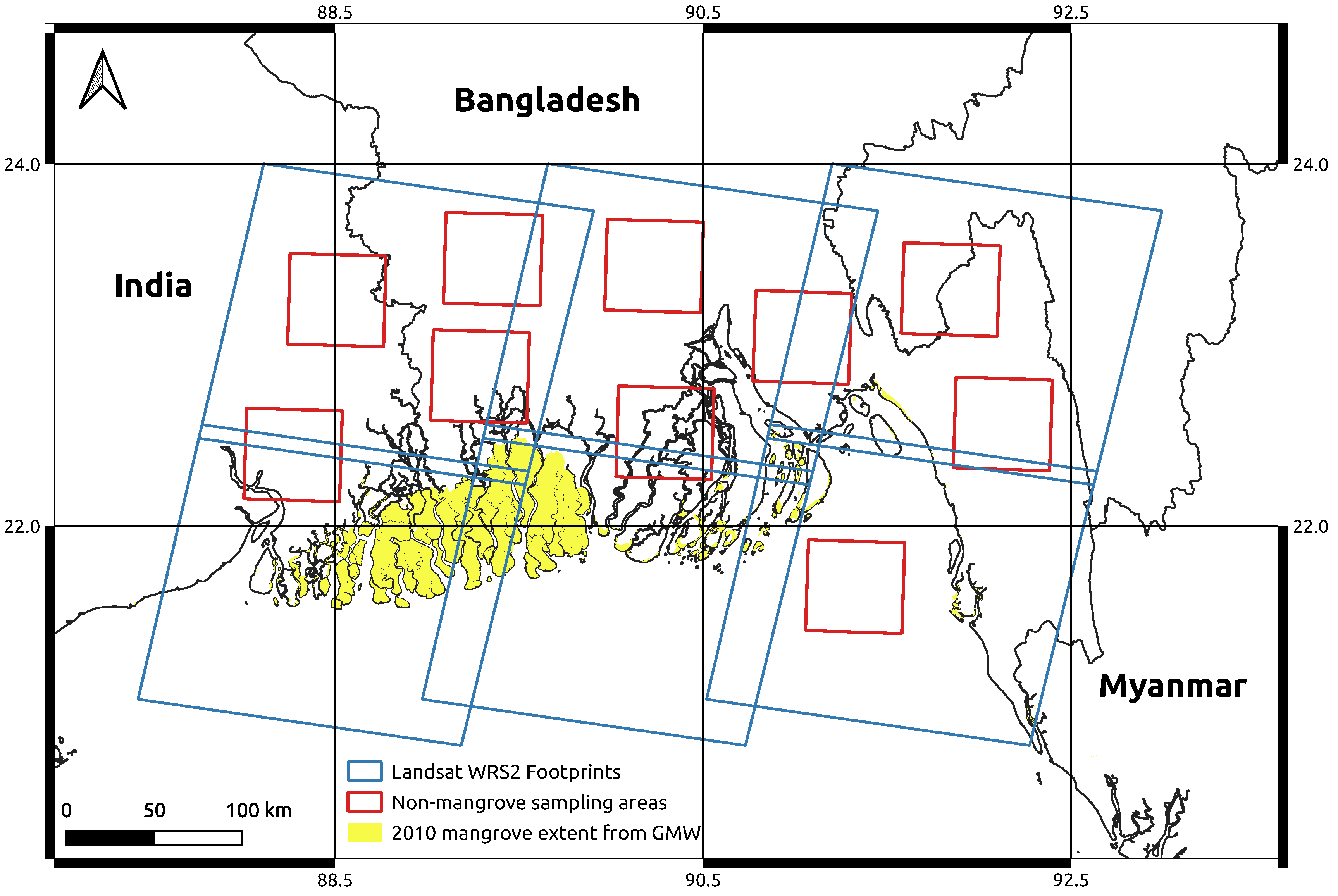
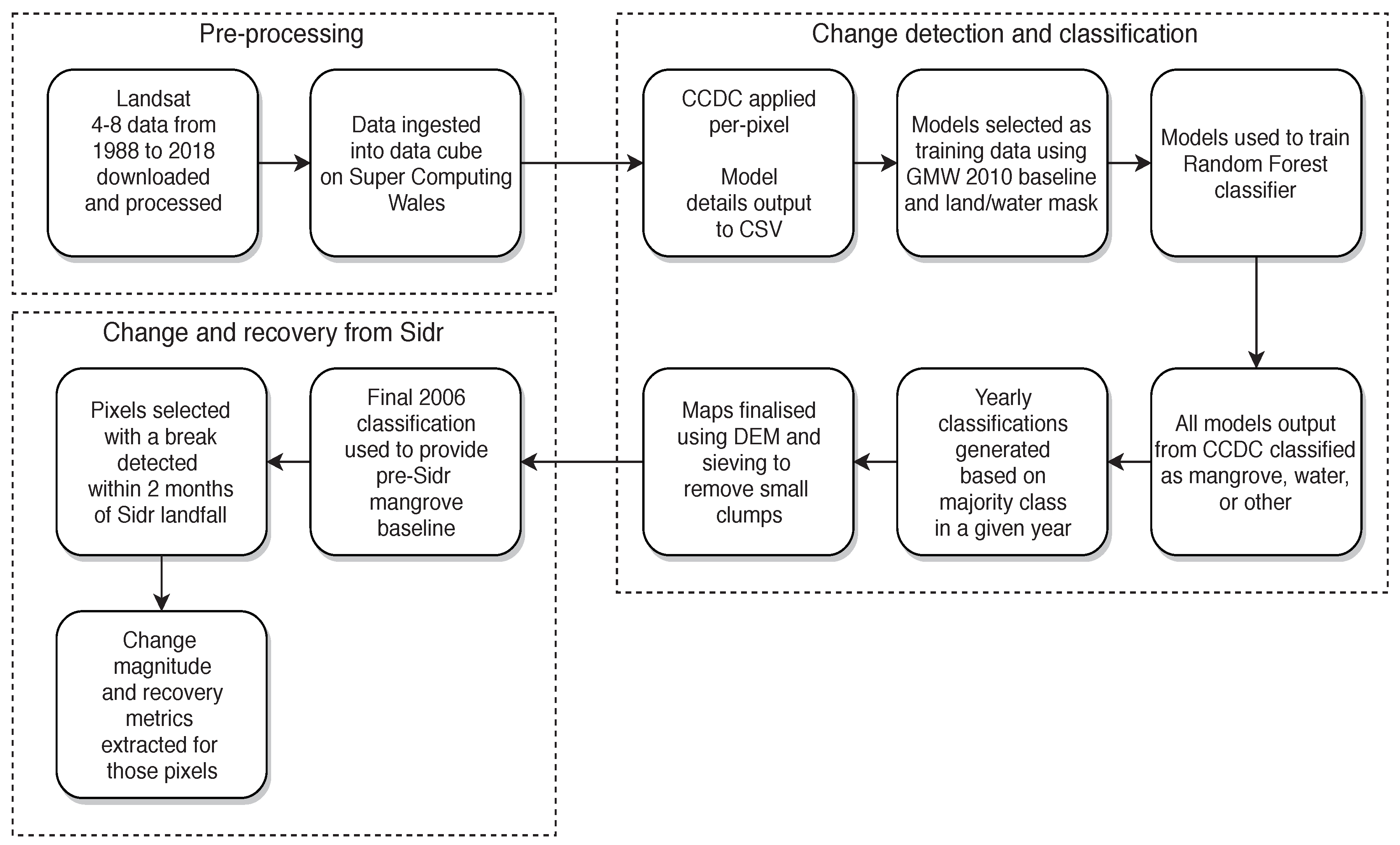

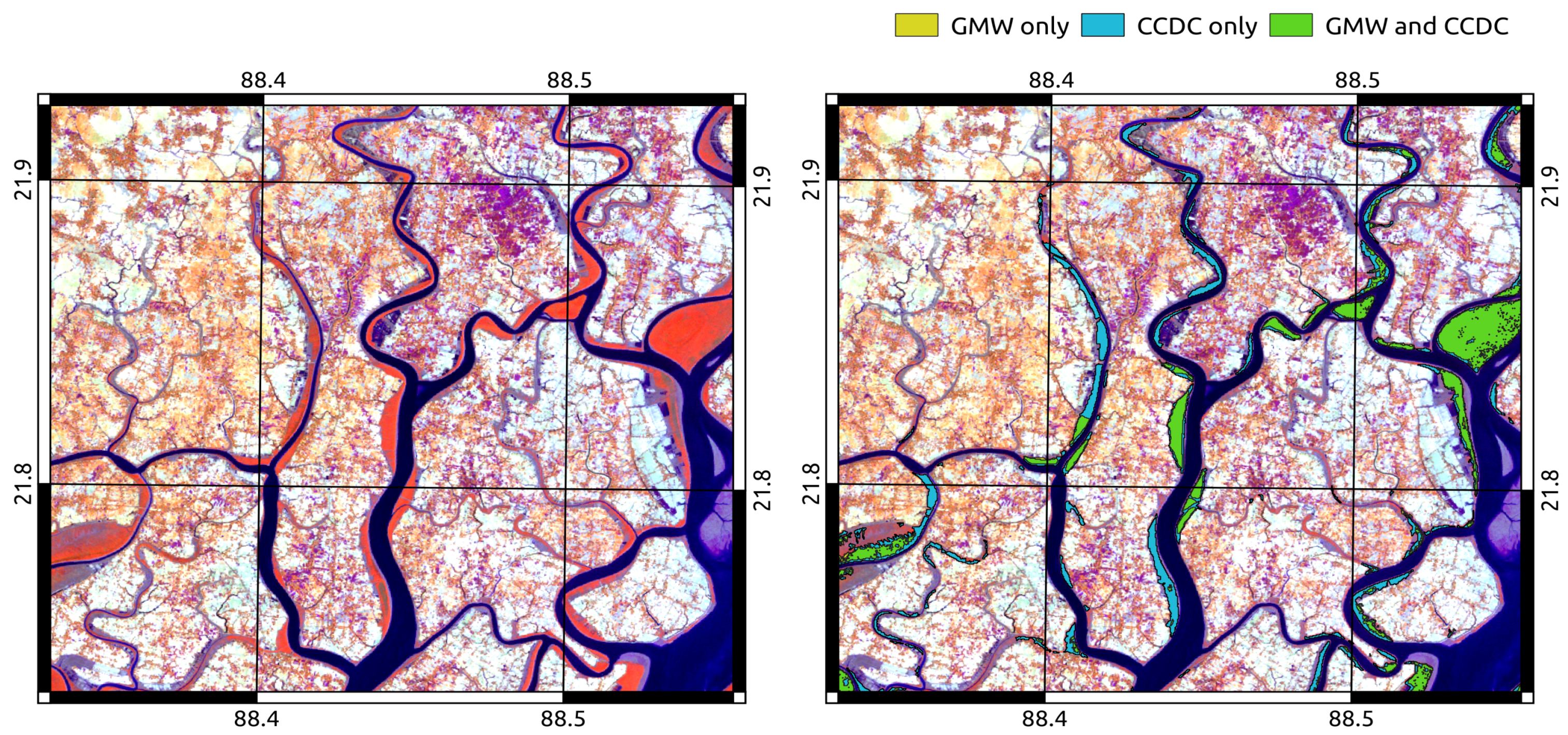
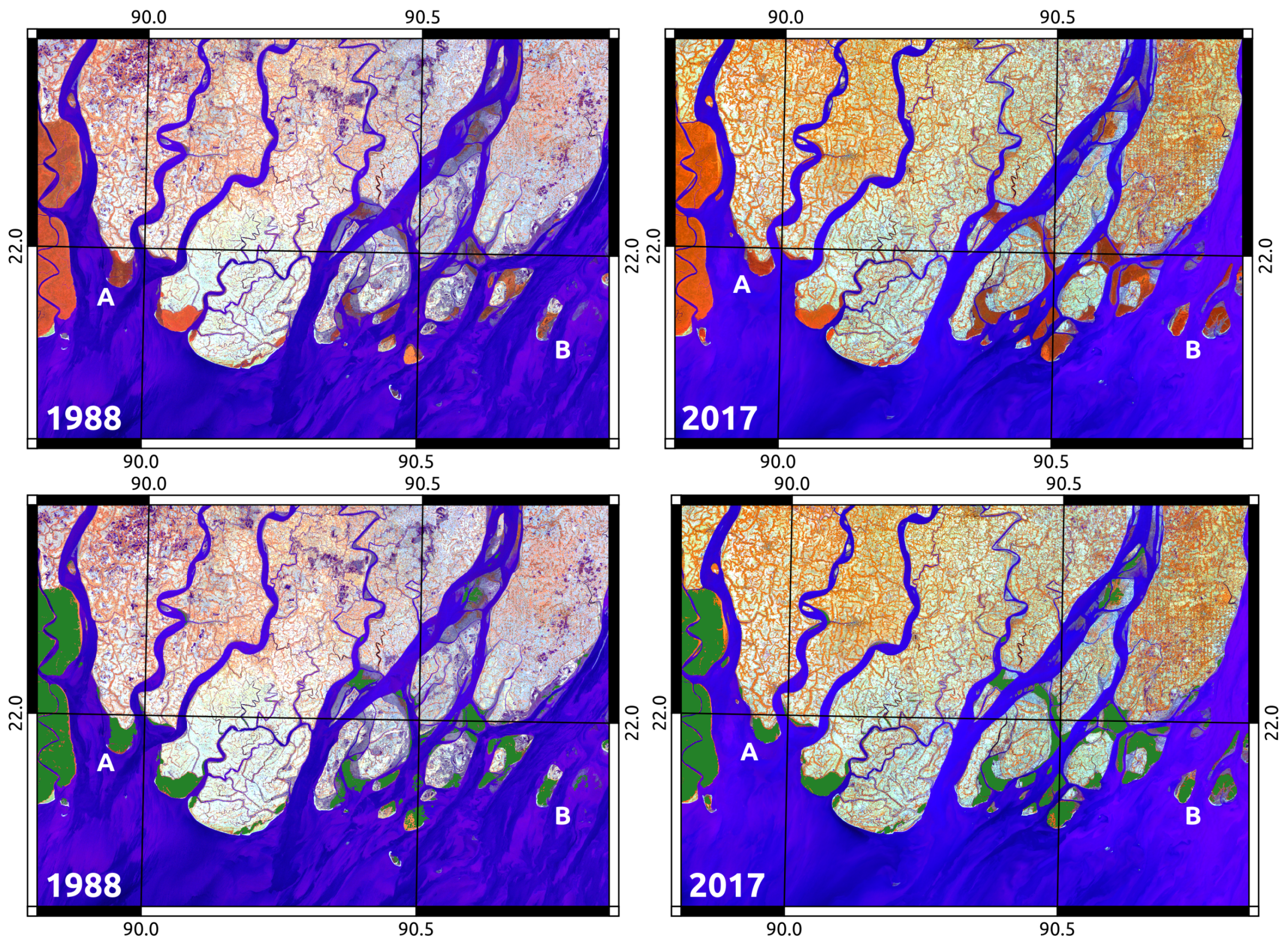
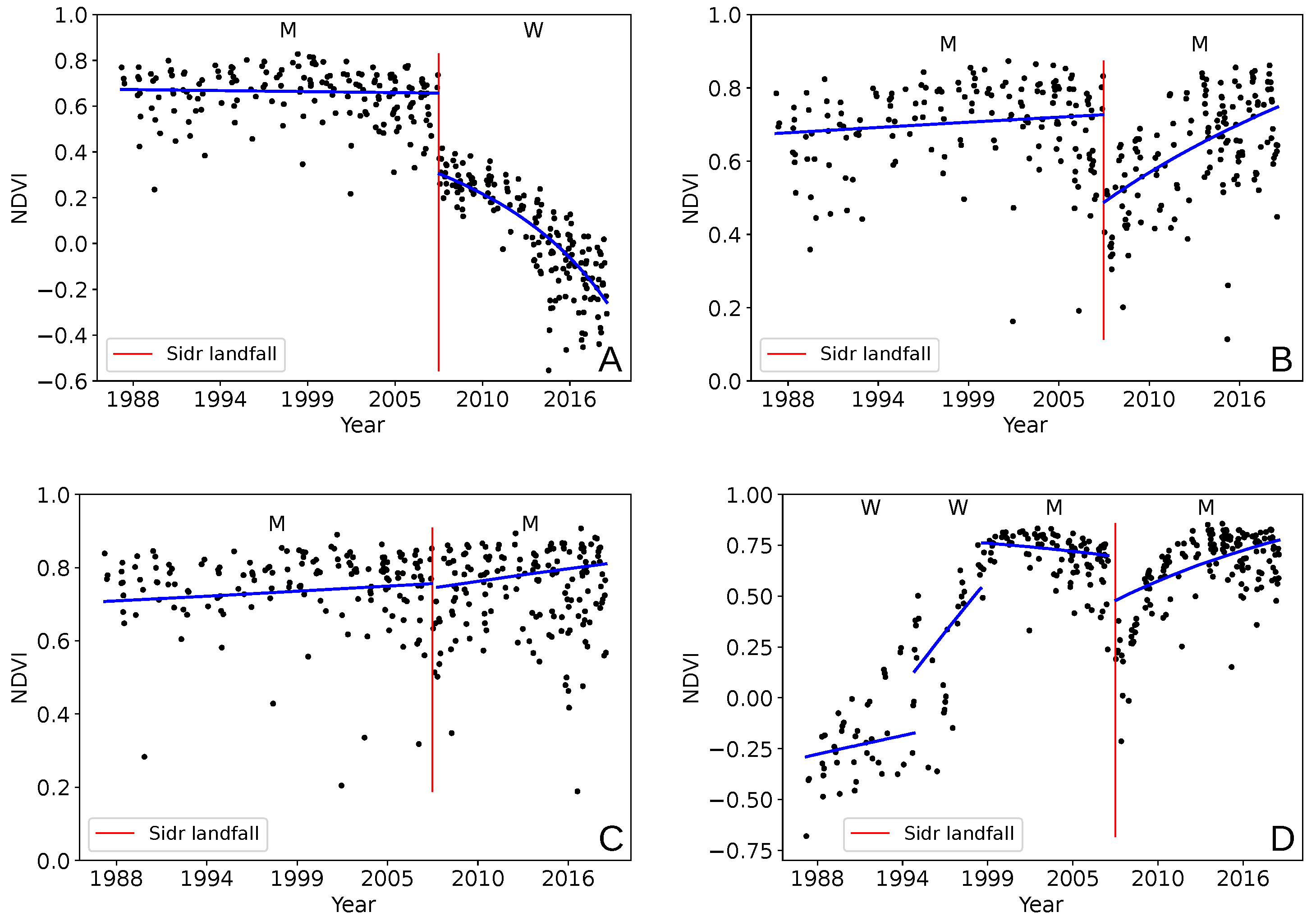
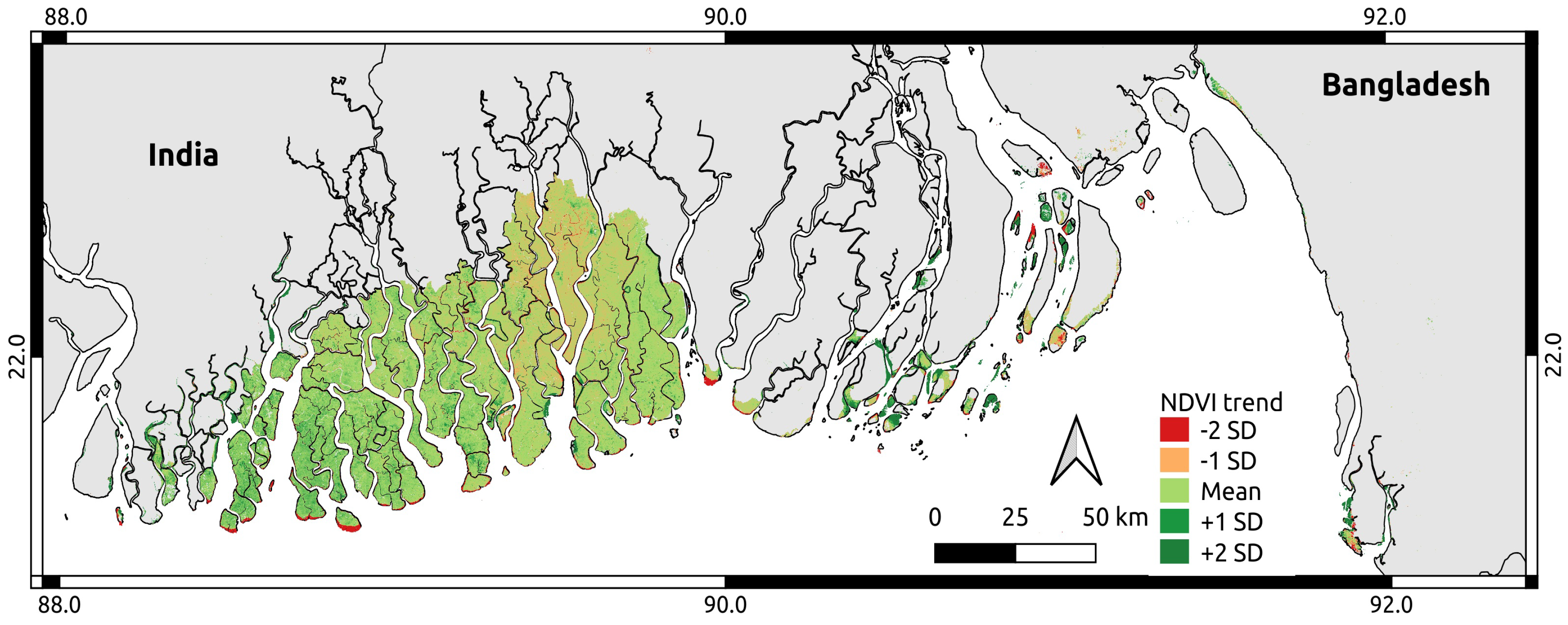
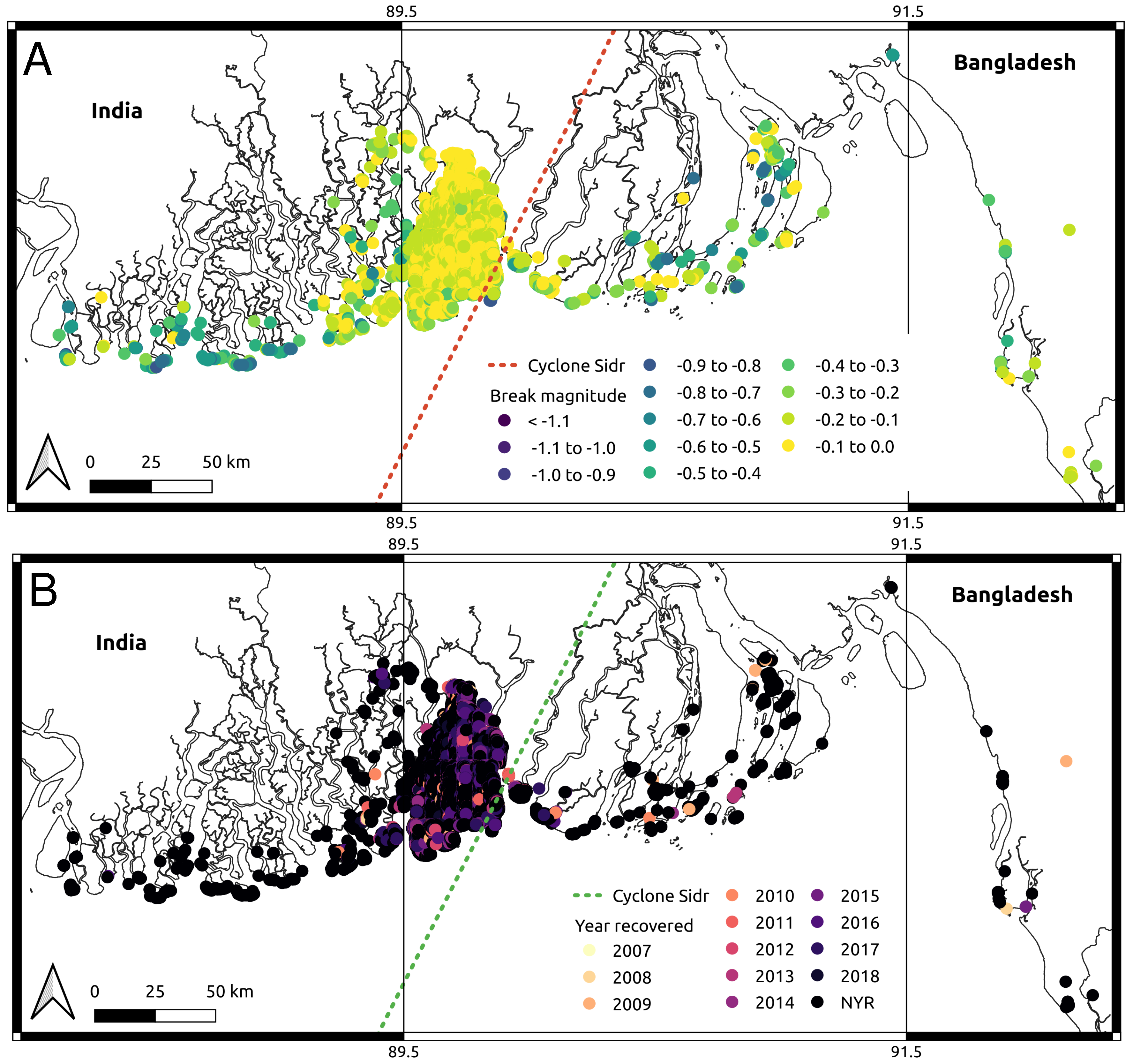
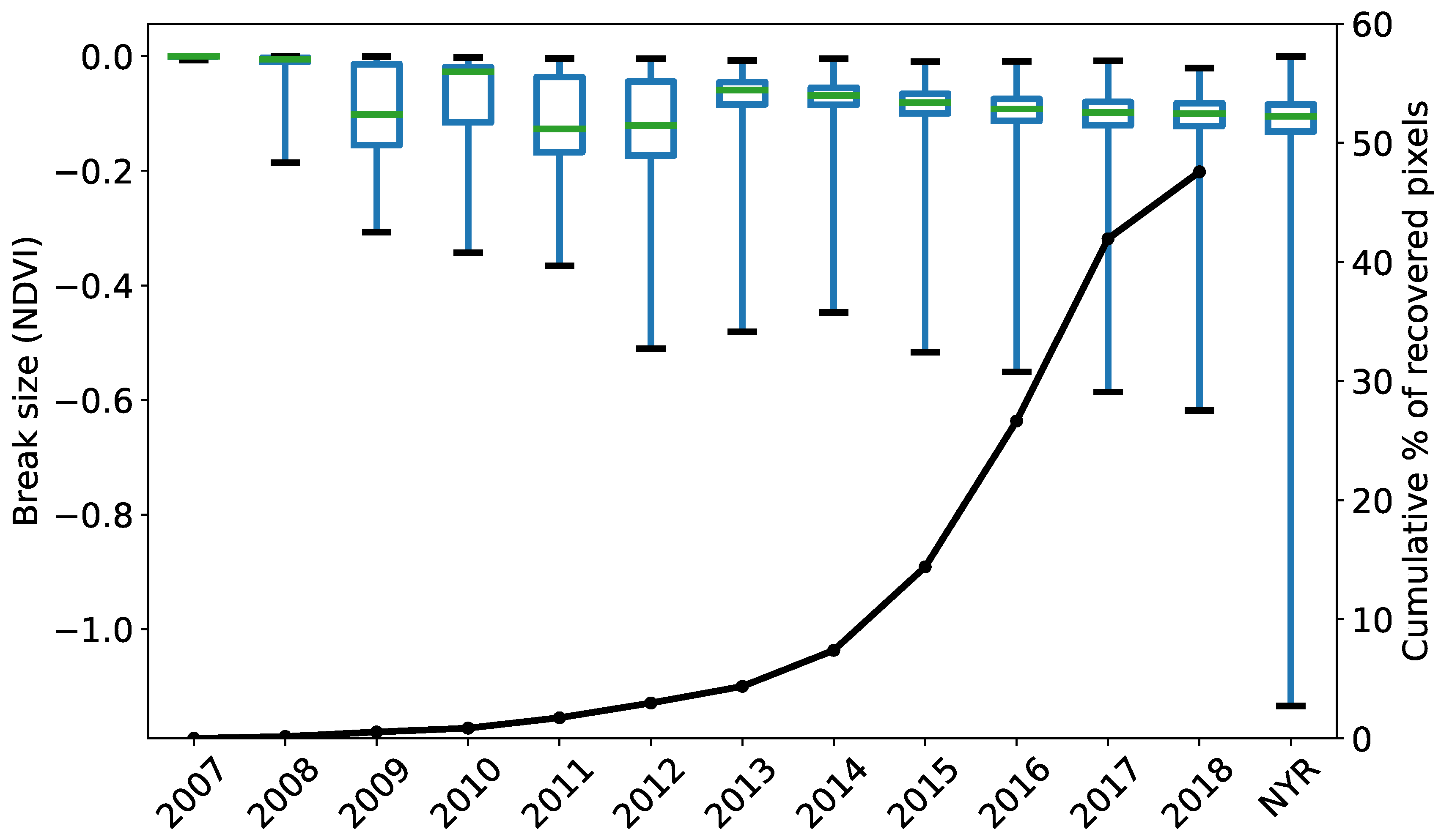
| Reference | ||||||
|---|---|---|---|---|---|---|
| Mangrove | Water | Other | Total | User’s (%) | ||
| Classifier | Mangrove | 11,835 | 531 | 219 | 12,585 | 94.0 |
| Water | 174 | 22,422 | 367 | 22,963 | 97.6 | |
| Other | 684 | 609 | 8599 | 9892 | 86.9 | |
| Total | 12,693 | 23,562 | 9185 | 45,440 | ||
| Producer’s (%) | 93.2 | 95.2 | 93.6 | 94.5 |
© 2019 by the authors. Licensee MDPI, Basel, Switzerland. This article is an open access article distributed under the terms and conditions of the Creative Commons Attribution (CC BY) license (http://creativecommons.org/licenses/by/4.0/).
Share and Cite
Awty-Carroll, K.; Bunting, P.; Hardy, A.; Bell, G. Using Continuous Change Detection and Classification of Landsat Data to Investigate Long-Term Mangrove Dynamics in the Sundarbans Region. Remote Sens. 2019, 11, 2833. https://doi.org/10.3390/rs11232833
Awty-Carroll K, Bunting P, Hardy A, Bell G. Using Continuous Change Detection and Classification of Landsat Data to Investigate Long-Term Mangrove Dynamics in the Sundarbans Region. Remote Sensing. 2019; 11(23):2833. https://doi.org/10.3390/rs11232833
Chicago/Turabian StyleAwty-Carroll, Katie, Pete Bunting, Andy Hardy, and Gemma Bell. 2019. "Using Continuous Change Detection and Classification of Landsat Data to Investigate Long-Term Mangrove Dynamics in the Sundarbans Region" Remote Sensing 11, no. 23: 2833. https://doi.org/10.3390/rs11232833
APA StyleAwty-Carroll, K., Bunting, P., Hardy, A., & Bell, G. (2019). Using Continuous Change Detection and Classification of Landsat Data to Investigate Long-Term Mangrove Dynamics in the Sundarbans Region. Remote Sensing, 11(23), 2833. https://doi.org/10.3390/rs11232833






